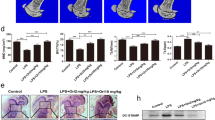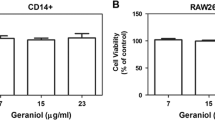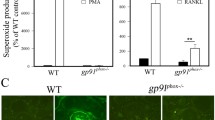Abstract
Osteoclastogenesis is an essential process in bone metabolism, which can be induced by RANKL stimulation. The F4/80 glycoprotein is a member of the EGF-transmembrane 7 (TM7) family and has been established as a specific cell-surface marker for murine macrophages. This study aimed to identify the role of F4/80 in osteoclastogenesis. Using mouse bone marrow-derived macrophages (BMMs), we observed that the mRNA level of F4/80 was dramatically reduced as these cells differentiated into osteoclasts. Furthermore, osteoclastogenesis was decreased in F4/80high BMMs compared to F4/80−/low BMMs. The inhibitory effect of F4/80 was associated with decreased expression of nuclear factor of activated T cells, cytoplasmic 1 (NFATc1). Ectopic overexpression of a constitutively active form of NFATc1 rescued the anti-osteoclastogenic effect of F4/80 completely, suggesting that the anti-osteoclastogenic effect of F4/80 was mainly due to reduction in NFATc1 expression. As an underlying mechanism, we demonstrated that the presence of F4/80 abrogated the effect of RANKL on the phosphorylation of CREB and activated the expression of IFN-β, which are restored by cyclic AMP. Collectively, our results demonstrate that the presence of F4/80 suppresses RANKL-induced osteoclastogenesis by impairing the expression of NFATc1 via CREB and IFN-β. Therefore, F4/80 may hold therapeutic potential for bone destructive diseases.




Similar content being viewed by others
References
Anderson DM, Maraskovsky E, Billingsley WL, Dougall WC, Tometsko ME, Roux ER, Teepe MC, DuBose RF, Cosman D, Galibert L (1997) A homologue of the TNF receptor and its ligand enhance T-cell growth and dendritic-cell function. Nature 390:175–179
Arai F, Miyamoto T, Ohneda O, Inada T, Sudo T, Brasel K, Miyata T, Anderson DM, Suda T (1999) Commitment and differentiation of osteoclast precursor cells by the sequential expression of c-Fms and receptor activator of nuclear factor kappa B (RANK) receptors. J Exp Med 190:1741–1754
Asagiri M, Takayanagi H (2007) The molecular understanding of osteoclast differentiation. Bone 40:251–264
Cosman F (2008) Parathyroid hormone treatment for osteoporosis. Curr Opin Endocrinol Diabetes Obes 15:495–501
Gordon S, Hamann J, Lin HH, Stacey M (2011) F4/80 and the related adhesion-GPCRs. Eur J Immunol 41:2472–2476
Işeri SO, Sener G, Yüksel M, Contuk G, Cetinel S, Gedik N, Yegen BC (2005) Ghrelin against alendronate-induced gastric damage in rats. J Endocrinol 187:399–406
Josse R, Khan A, Ngui D, Shapiro M (2013) Denosumab, a new pharmacotherapy option for postmenopausal osteoporosis. Curr Med Res Opin 29:205–216
Karsenty G, Wagner EF (2002) Reaching a genetic and molecular understanding of skeletal development. Dev Cell 2:389–406
Kim JH, Kim N (2014) Regulation of NFATc1 in osteoclast differentiation. J Bone Metab 21:233–241
Lacey DL, Timms E, Tan HL, Kelley MJ, Dunstan CR, Burgess T, Elliott R, Colombero A, Elliott G, Scully S, Hsu H, Sullivan J, Hawkins N, Davy E, Capparelli E, Eli A, Qian YX, Kaufman S, Sarosi I, Shalhoub V, Senaldi G, Guo J, Delaney J, Boyle WJ (1998) Osteoprotegerin ligand is a cytokine that regulates osteoclast differentiation and activation. Cell 93:165–176
Lee ZH, Kim HH (2003) Signal transduction by receptor activator of nuclear factor kappa B in osteoclasts. Biochem Biophys Res commun 305:211–214
Lee JY, Kim KJ, Kim J, Choi SU, Kim SH, Ryu SY (2016) Anti-osteoclastogenic effects of isoquinoline alkaloids from the rhizome extract of Sinomenium acutum. Arch Pharm Res 39:713–720
Lin HH, Faunce DE, Stacey M, Terajewicz A, Nakamura T, Zhang-Hoover J, Kerley M, Mucenski ML, Gordon S, Stein-Streilein J (2005) The macrophage F4/80 receptor is required for the induction of antigen-specific efferent regulatory T cells in peripheral tolerance. J Exp Med 201:1615–1625
Papapoulos SE (2000) Bisphosphonates in the treatment of osteoporosis. Ann Med Interne (Paris) 151:504–510
Quinn JM, Whitty GA, Byrne RJ, Gillespie MT, Hamilton JA (2002) The generation of highly enriched osteoclast-lineage cell populations. Bone 30:164–170
Rodan GA, Martin TJ (2000) Therapeutic approaches to bone diseases. Science 289:1508–1514
Sato K, Suematsu A, Nakashima T, Takemoto-Kimura S, Aoki K, Morishita Y, Asahara H, Ohya K, Yamaguchi A, Takai T, Kodama T, Chatila TA, Bito H, Takayanagi H (2006) Regulation of osteoclast differentiation and function by the CaMK-CREB pathway. Nat Med 12:1410–1416
Schaller E, Macfarlane AJ, Rupec RA, Gordon S, McKnight AJ, Pfeffer K (2002) Inactivation of the F4/80 glycoprotein in the mouse germ line. Mol Cell Biol 22:8035–8043
Takayanagi H, Kim S, Matsuo K, Suzuki H, Suzuki T, Sato K, Yokochi T, Oda H, Nakamura K, Ida N, Wagner EF, Taniguchi T (2002) RANKL maintains bone homeostasis through c-Fos-dependent induction of interferon-beta. Nature 416:744–749
Teitelbaum SL (2000) Bone resorption by osteoclasts. Science 289:1504–1508
Teitelbaum SL, Ross FP (2003) Genetic regulation of osteoclast development and function. Nat Rev 4:638–649
Tinkler SM, Linder JE, Williams DM, Johnson MW (1981) Formation of osteoclasts from blood monocytes during 1 alpha-OH Vit D-stimulated bone resorption in mice. J Anat 133:389–396
Vogel VG, Costantino JP, Wickerham DL, Cronin WM, Cecchini RS, Atkins JN, Bevers TB, Fehrenbacher L, Pajon ER Jr, Wade JL 3rd, Robidoux A, Margolese RG, James J, Lippman SM, Runowicz CD, Ganz PA, Reis SE, McCaskill-Stevens W, Ford LG, Jordan VC, Wolmark N, National Surgical Adjuvant Breast and Bowel Project (NSABP) (2006) Effects of tamoxifen vs raloxifene on the risk of developing invasive breast cancer and other disease outcomes: the NSABP Study of Tamoxifen and Raloxifene (STAR) P-2 trial. JAMA 295:2727–2741
Walsh MC, Kim N, Kadono Y, Rho J, Lee SY, Lorenzo J, Choi Y (2006) Osteoimmunology: interplay between the immune system and bone metabolism. Annu Rev Immunol 24:33–63
Wen AY, Sakamoto KM, Miller LS (2010) The role of the transcription factor CREB in immune function. J Immunol 185:6413–6419
Yavropoulou MP, Yovos JG (2008) Osteoclastogenesis–current knowledge and future perspectives. J Musculoskelet Neuronal Interact 8:204–216
Acknowledgments
This work was supported by Grants from the Korean Health Technology R&D Project, Ministry of Health & Welfare, Republic of Korea (HI14C24470000) and from the National Research Foundation of Korea (NRF), funded by Ministry of Science, ICT and Future Planning (MSIP) (NRF-2014M1A3A3A02034917).
Author information
Authors and Affiliations
Corresponding author
Ethics declarations
Conflict of interest
The authors declare no conflict of interest.
Additional information
Ju-Hee Kang and Jung-Sun Sim have contributed equally to this work.
Electronic supplementary material
Below is the link to the electronic supplementary material.
Rights and permissions
About this article
Cite this article
Kang, JH., Sim, JS., Zheng, T. et al. F4/80 inhibits osteoclast differentiation via downregulation of nuclear factor of activated T cells, cytoplasmic 1. Arch. Pharm. Res. 40, 492–499 (2017). https://doi.org/10.1007/s12272-017-0900-7
Received:
Accepted:
Published:
Issue Date:
DOI: https://doi.org/10.1007/s12272-017-0900-7




